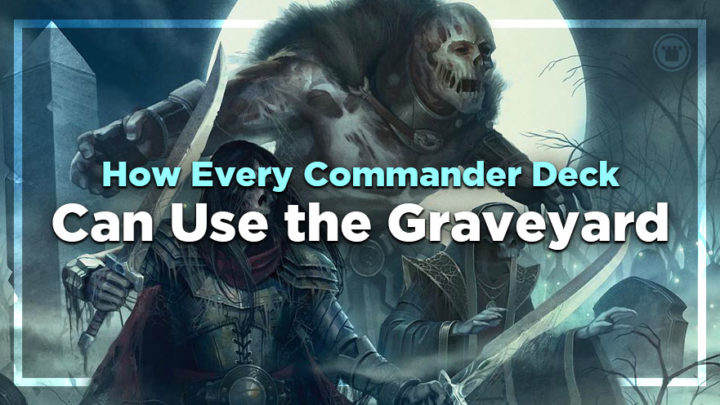When many players think of graveyard strategies, they tend to think of commanders like Meren of Clan Nel Toth and Muldrotha, the Gravetide. While these are some of the most obvious choices for a graveyard deck, they’re certainly on the more extreme end of the scale. There’s so much more to the graveyard than total dedication, and most decks can reap some benefit from including it in their plans.
I’m of the opinion that all Commander decks should have a plan for the graveyard in some form, regardless of the commander you choose to run. It’s a zone that’s available to everyone, yet many people ignore it completely, as they think they’re not playing a “graveyard deck”; doing so only serves to hamstring the deck’s ability to grind or adapt. Even a small amount of recursion can go a long way toward turning a good deck into a great one, and it can be achieved with very little effort.
I’ll list a number of different ways you can incorporate the graveyard into your builds, regardless of the color(s) or strategy. Note that these aren’t going to make your deck fold to graveyard hate, but rather help to give you some extra fuel or angles of attack.
“To-Hand” Recursion
This is probably the most popular form of recursion in Commander. Returning a card from the graveyard to hand is a useful ability that scales well as the game goes on. The way I see it, these cards tutor for any card that you’ve already used, turning your yard into a smorgasbord of value. They can also help to protect your win conditions by rebuying them; I’ve lost many games after countering an infinite combo, only for my opponent to play an Eternal Witness and try again!
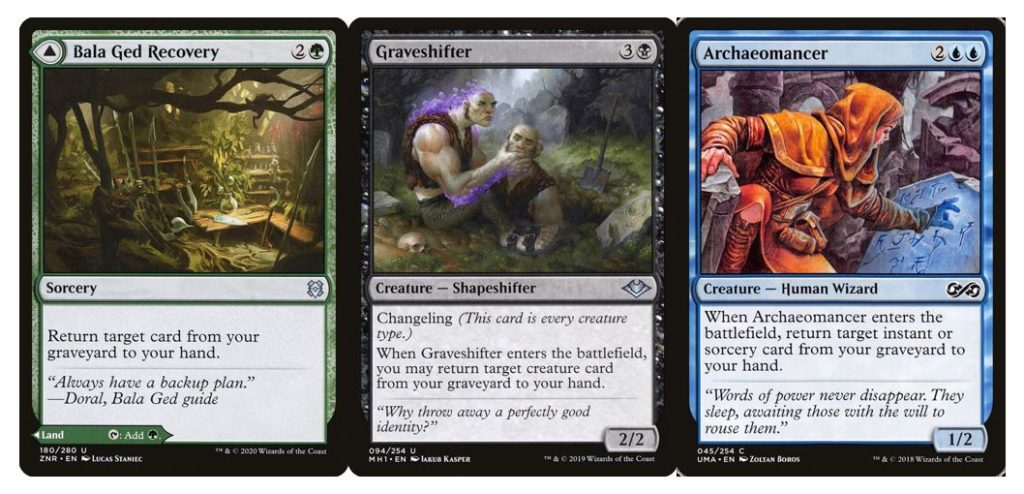
Green is notably better at this than other colors, with Bala Ged Recovery and Regrowth allow you to return any card from the graveyard. Black mainly focuses on creature recursion with the likes of Graveshifter and Palace Siege, and blue generally can only return instants or sorceries.
Some recursion spells can occasionally be involved in combos, too. Archaeomancer generates infinite mana with a Peregrine Drake and Ghostly Flicker; you can flicker both creatures to untap five lands and return Ghostly Flicker to your hand, then repeat the process. This can give greater flexibility to your win conditions by having them be generally decent cards on their own.
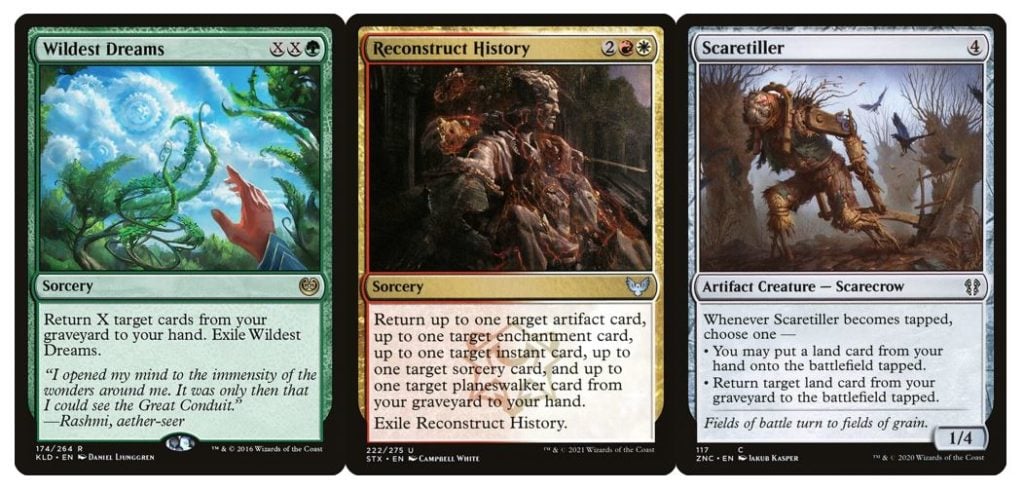
There’s more available than single-use Regrowth effects, too. Cards like Wildest Dreams and Long Rest can become a form of card advantage for green decks that like to play a longer game. The flexibility of these cards is one of their greatest strengths; you can cash one in early as a Regrowth if you wish, or hold out for a big recovery turn later in the game.
Reconstruct History is a unique option in red and white, and I’ve sung its praises before as a great value piece in those colors. Provided you have a reasonable spread of card types, any Boros deck should consider this to help recover after a wipe or untimely wheel effect.
Scaretiller is a great choice as a repeatable value engine in landfall decks, or decks with fetch lands. I’ve seen it work wonders in Cosima, God of the Voyage decks in particular, though any decks with lands in the graveyard will make great use of them. With so many different options at your fingertips, you’re bound to find some to-hand recursion that will suit your deck.
Graveyard Value Spells
Now we move on to my favorite option: graveyard spells. To clarify, these are spells that you can cast from the graveyard, or cards with abilities you can use while they’re in the bin. Not only do these give you more things to do in every game, but they could help mitigate discard from spells like Cathartic Reunion, or give you extra value from getting milled (intentionally or otherwise).
Red tends to be the color with the most varied and interesting options in this category, but all colors have plenty of choices available. Here are some examples:
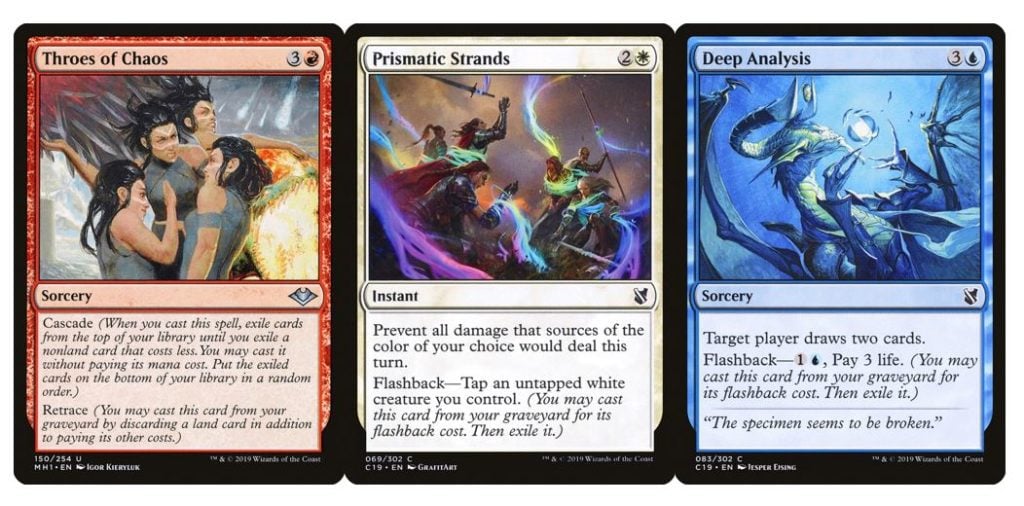
Throes of Chaos is a spell that I’ve started adding to almost every red deck I build. Not only does it give you graveyard value, but it’s a repeatable way to mitigate flooding. It won’t fit perfectly in decks with many counterspells, but otherwise, it’s a fantastic way to turn dead draws into live ones.
Prismatic Strands is a Pauper staple, effectively acting as two fog spells in one to help win aggressive races. It can play brilliantly in Commander, too — either protecting you from an alpha strike, or saving your board from a Blasphemous Act. The flashback cost is among the lowest possible, and you can even use a summoning sick creature to pay for it!
Blue isn’t lacking card advantage, but your blue decks will gladly accept more. Deep Analysis draws you four cards in two installments, and still provides card advantage if it’s discarded or milled instead.
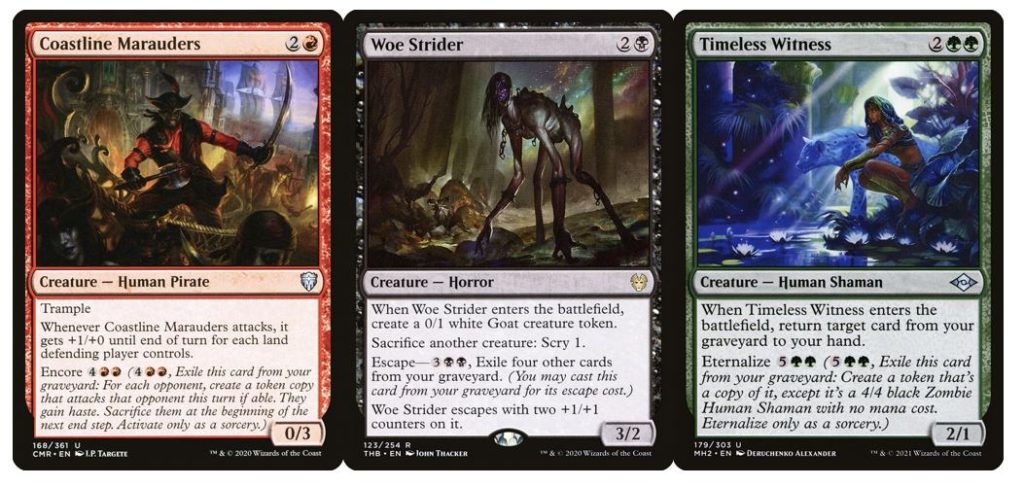
There are also plenty of activated abilities that can only be used when the card is in the yard. Encore is one such ability from Commander Legends; it’s like the unearth mechanic, but for multiple opponents. Activating encore on Coastline Marauders can give you three enormous threats to cut your opponents down to size, and bringing back Impulsive Pilferer can nab you a few treasures for a particularly explosive subsequent turn.
Escape is a mechanic from Theros Beyond Death that lets you replay spells from the graveyard. Woe Strider is among the best options for Commander, as it’s a sacrifice outlet that just won’t quit. The best part about escape is that you can keep replaying those spells from the bin, provided you have enough other cards to exile to its cost. In less graveyard-intensive decks, one or two escape cards should function perfectly fine by themselves.
Finally, eternalize from Amonkhet block allows you to bring back a creature as a 4/4 Zombie token copy. Timeless Witness is the newest card to feature this ability, and even pulls double duty as a “to-hand” recursion spell for even more graveyard value!
Actual Factual Reanimation
As we travel further into the depths of the graveyard, we come to more dedicated options. Reanimation, typically associated with black, can be an entire strategy by itself, but this doesn’t mean you need to go all-in on it. Much like the Regrowth effects I mentioned earlier, reanimation grants additional uses of your discarded or spent cards, giving you more options in each game. Black and white are the two primary colors associated with this kind of graveyard effect; black is more heavily focused on returning creatures, whereas some white cards allow other permanents to return (like Sun Titan).
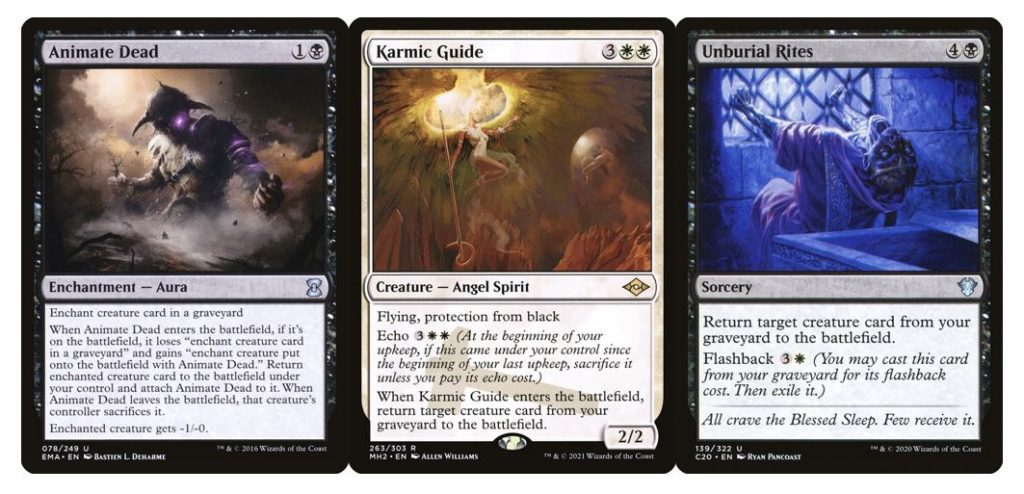
There are a plethora of single target reanimation spells available in black and white, with Animate Dead being one of the most (in)famous. There are two important points of note about this enchantment that make it more than a regular reanimation spell. First, it brings back a creature from any graveyard; you don’t even need to have a creature in the bin to reanimate, as long as your opponent has one in theirs! Also, like Archaeomancer, it can be used as a combo piece. Reanimating a Worldgorger Dragon with this spell causes a continuous loop: the Worldgorger Dragon enters the battlefield and exiles Animate Dead, causing the Dragon to die, which returns Animate Dead to bring back the Dragon again.
Karmic Guide is similar in its use: it can be a decent card to take advantage of some mild graveyard effects, or it can be made part of a combo. There are many different ones available, all of which you can find on this dedicated EDHREC page.
If you happen to be in Orzhov colors, Unburial Rites is a classic reanimation spell. It’s a fine rate for the effect, but the addition of flashback makes this almost the reanimation equivalent to cards like Timeless Witness — you can reanimate two things, or gain value from discarding or milling it!
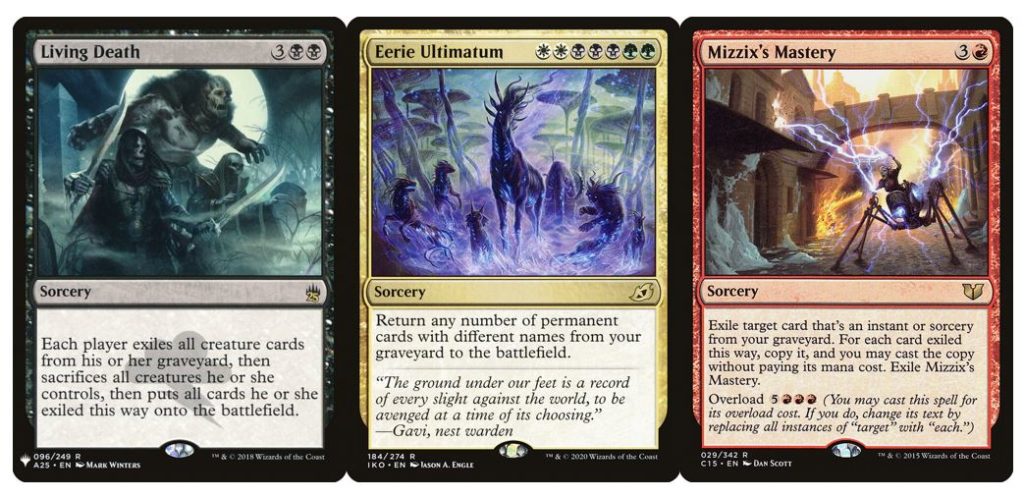
Finally, if you’re looking for something a bit more high impact, there are a number of mass-reanimate spells available. Living Death is revered and feared in equal measures, and it’s one of the de facto reanimator spells. It is usually only seen in more graveyard-centric strategies, but if you decide to lean in that direction, you’ll be hard pressed to find a better choice.
If your deck’s colors allow for it, you can run Eerie Ultimatum as a more impactful value reanimation spell. Thanks to the singleton nature of Commander, it effectively reads “Return all permanents from your graveyard to the battlefield”; after just one board wipe, this can put you so far ahead that your opponents could struggle to ever catch up with you.
Finally, while it’s not exactly a reanimation spell in the traditional sense, Mizzix’s Mastery is certainly worth mentioning. Too many players think that only Spellslinger or Storm decks will want to run this, but as long as you have a reasonable number of instants and sorceries, Mizzix’s Mastery will give you a rush of value to help you pull ahead. Even if you don’t overload it, having access to any one spell that you’ve cast before can often be more than enough!
Run More Graveyard Hate
So far, this may read like an article on how to add graveyard shenanigans to your deck, but it’s a little more than that. As I said at the start, all decks should have a plan for the graveyard in some form, regardless of the commander you choose to run. I would consider graveyard hate to be a viable plan, and it can be more powerful than you think.
While I believe most decks should utilize the graveyard in some form, that doesn’t mean you can stand to ignore it currently. The ability to lock down an entire zone of the game is extremely powerful, and it can come in many different forms to suit your strategy.
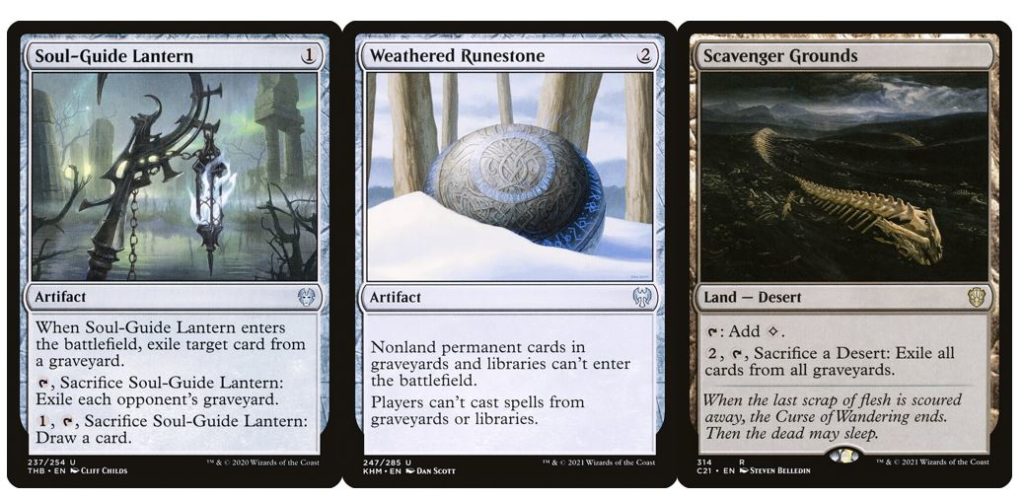
You can go for single-use graveyard removal if you don’t fear graveyard-heavy decks, or if you don’t want to attract players’ ire by playing Leyline of the Void or Rest in Peace. Soul-Guide Lantern is one of the newer graveyard hate spells on the scene, but it’s already making a name for itself. First, it removes a single card when it enters the battlefield, which is useful for taking out a flashback spell or reanimation target. You can also hold it up as an emergency button to wipe graveyards instantly, or it can simply replace itself for a single mana. The real benefit to Soul-Guide Lantern is that it hits every graveyard except your own, leaving you free to get all the value you want out of your bin!
Cards like Weathered Runestone or Grafdigger’s Cage are useful for more taxing decks that may not want to utilize their graveyards much. Weathered Runestone’s nonland clause is a bit better than the Cage’s creature clause, as it can stop Sun Titan or Sevinne’s Reclamation dead in their tracks as well. Its added hate for library shenanigans is much more than incidental, too: with it on board, a Finale of Devastation can’t fetch that Craterhoof Behemoth, and Whir of Invention can’t pick up an Aetherflux Reservoir!
Scavenger Grounds is a land that a number of decks could easily run. It could be hard to fit it into an Omnath, Locus of Creation deck, for instance, but most decks with three or fewer colors should be able to find room somewhere. If you know you need to run graveyard hate but don’t want to remove one of your more fun cards, then this may be the option for you! Bojuka Bog is another option in black, though it generally lacks the ability to exile at instant speed, and it only hits one player.
***
There’s an awful lot more to graveyards in Commander than just Muldrotha decks and Underworld Breach combos. No matter the type of deck you’re building or tuning, you can always find some way to use the best zone in Magic to your advantage.
Do you use the graveyard in your decks? Do you have any favorite graveyard-centric cards? I’d love to hear about your favorite tech over on Twitter!

Scott is an Irish content creator and the Head of Budget Magic for the Izzet League. He focuses on affordable decks in Pioneer, Modern, and Pauper, particularly ones that stray from the mainstream. When he’s not writing about his favorite decks, he can be found talking incessantly about them on Twitter and on The Budget Magic Cast.

